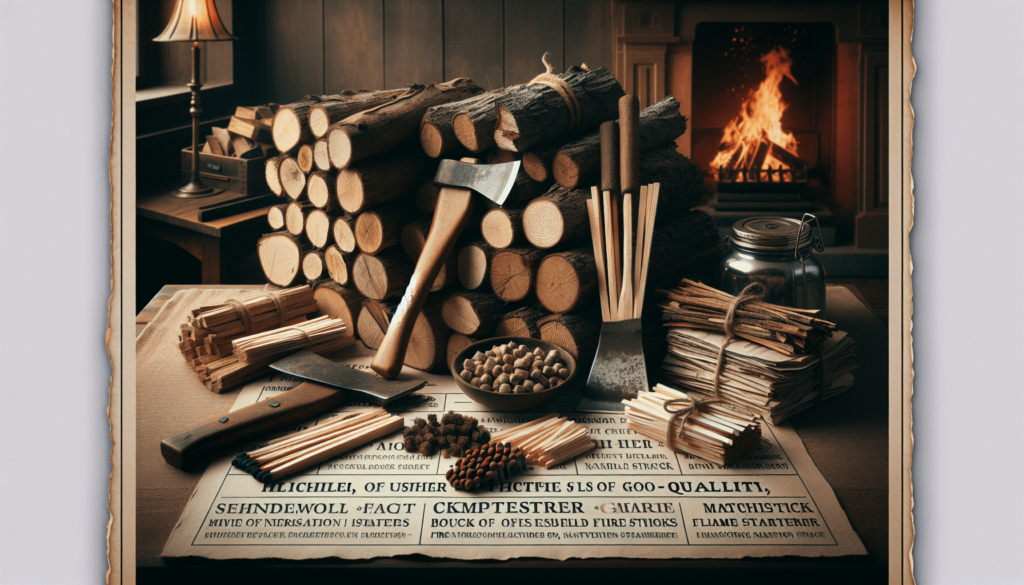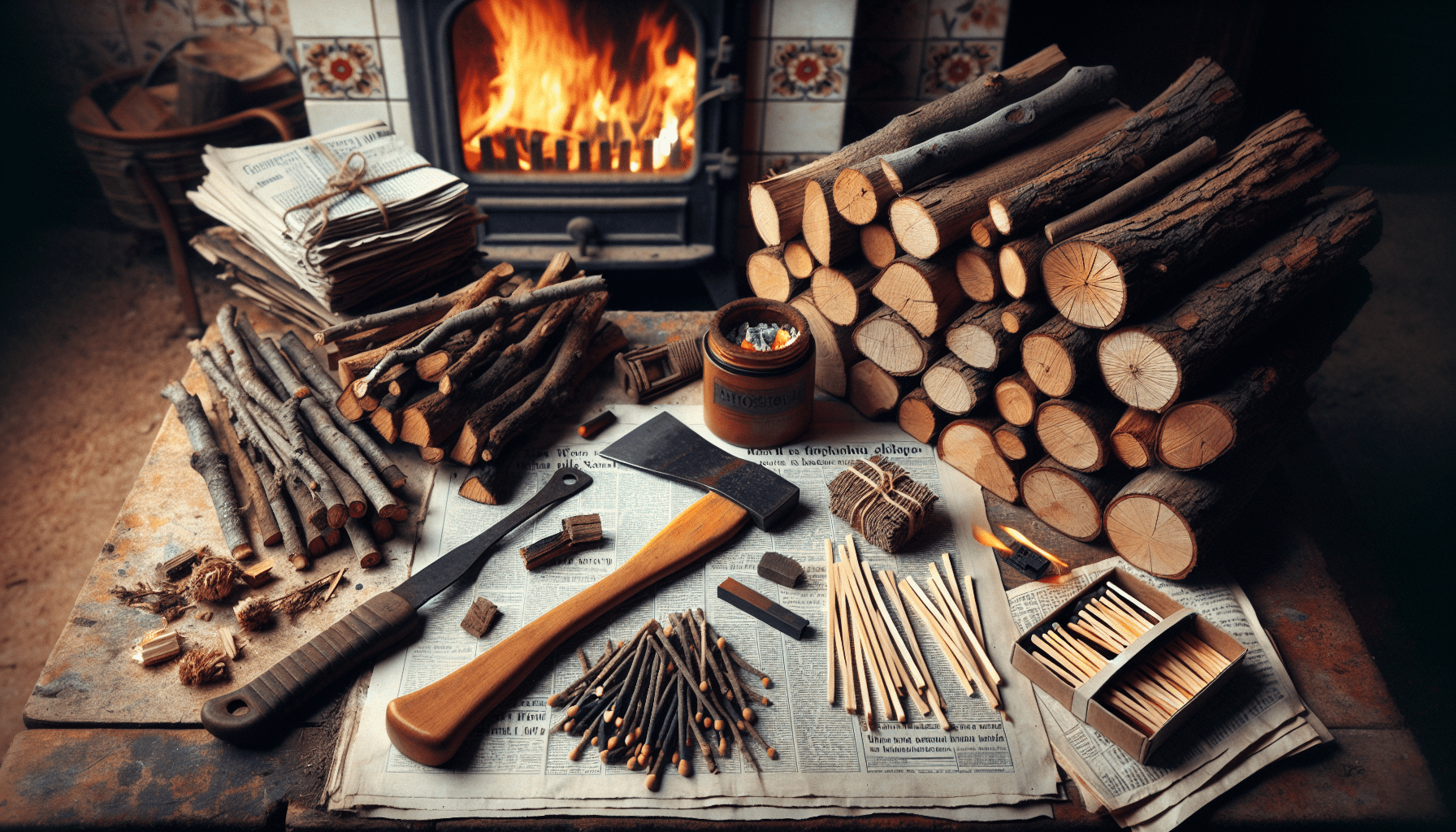Do you ever find yourself staring at an empty fireplace or a fire pit, wondering what you need to get that cozy wood fire going? Trust me, you’re not alone. I’ve been there myself, standing in front of a bunch of logs and kindling with a matchbook in hand, unsure if I’m doing it right. Fear not, my friend. Building a wood fire can be straightforward when you know what items are essential and why they’re necessary. Let me guide you through it.

What Types of Wood Work Best?
Hardwoods vs. Softwoods
If you’ve ever thought that all wood burns the same, think again. Choosing the right type of wood can make a big difference in your fire’s quality and longevity. Generally, hardwoods like oak, maple, and hickory are better choices than softwoods like pine and cedar.
Hardwoods:
| Type | Burn Time | Heat Production |
|---|---|---|
| Oak | Long | High |
| Maple | Long | High |
| Hickory | Very Long | Very High |
Softwoods:
| Type | Burn Time | Heat Production |
|---|---|---|
| Pine | Short | Low |
| Cedar | Short | Low |
Hardwoods burn longer and produce more heat, which is something to consider on a particularly chilly evening.
Seasoned Wood
The term “seasoned wood” refers to wood that has been dried out to reduce moisture content. Freshly cut, or “green,” wood generally has a moisture content of 50% or more. In contrast, seasoned wood has a moisture content of less than 20%. Using seasoned wood not only makes your fire start easier but also ensures less smoke and higher efficiency.
Different Types of Fire Starters
Newspaper and Kindling
Believe it or not, one of the simplest ways to start a fire is using old newspapers. Just crumple them up and place them at the bottom of your fire pit or fireplace. Add a layer of kindling—those small sticks or twigs—to get the fire blazing quickly.
Kindling options:
| Kindling Type | Availability | Ease of Use | | |—————|————–|————-| | | Twigs | High | Easy | | | Small sticks | High | Easy | | | Pinecones | Medium | Moderate | |
Fire Starters: Chemical vs. Natural
For those who get a bit more nervous about starting fires, fire starters can be a lifesaver. These come in two main types: chemical and natural.
Chemical Fire Starters:
| Brand | Ease of Use | Burn Time |
|---|---|---|
| Duraflame | High | 10 minutes |
| Zip | High | 15 minutes |
Natural Fire Starters:
| Type | Availability | Ease of Use |
|---|---|---|
| Fatwood | Medium | Easy |
| Tinder | Medium | Moderate |
Whether you go for chemical or natural options, both have their advantages. I often lean toward natural fire starters for their eco-friendliness.
Essential Tools for Fire Building
Fireplace Poker and Tongs
If you’re a novice, these may seem unnecessary, but trust me, they are indispensable. Poker helps you adjust the logs, while tongs allow you to move them safely without burning yourself.
Fireproof Gloves
I can’t stress this enough: safety first. Fireproof gloves will protect your hands from both direct flame and the heat emanating from your fireplace.
Ash Pan and Broom
Once your glorious fire has burned out, you’ll be left with ashes. An ash pan and broom will make the cleanup process manageable. Life’s already complicated enough; let’s not make cleaning up after a fire an added stressor.
Safety Precautions
Fire Extinguisher
Have one of these ready at all times. It doesn’t matter how experienced you are, accidents can happen.
Fire Screen
A fire screen serves as a barrier to prevent sparks from flying out of the fireplace or fire pit and potentially starting unintended fires.
Smoke Detectors
If you don’t already have them installed, now is the time. A functioning smoke detector can be a lifesaver.
Techniques for Building a Fire
Teepee Method
The teepee method involves arranging the logs into a conical structure. Place your kindling and tinder in the center and build the larger logs around them. This method allows for optimal air circulation, helping your fire to ignite more quickly.
Log Cabin Method
This approach is another effective way to build a fire. Stack two logs parallel to each other on the bottom, followed by another layer of two logs perpendicular to the first set. Continue stacking this way. This creates a structure that allows for good airflow and a steady burn.
Maintaining the Fire
Adding Logs
Keep an eye on your fire and add logs as needed. Too many logs at once can smother it; too few, and it may die out.
Aeration
Use your poker to occasionally stir the logs and embers to maintain good airflow and encourage a steady burn.

How to Extinguish a Fire
Letting it Burn Out
The safest way to extinguish a fire is to let it burn out naturally. If you’re not in a hurry, this is your best bet.
Dousing with Water
If you need to put out the fire more quickly, gradually pour water over the ashes while stirring them with your poker. Ensure there are no remaining hot spots before leaving the area.
Using Sand or Dirt
In the absence of water, sand or dirt can be used to cover the embers and cut off the oxygen supply, extinguishing the fire.
Common Mistakes to Avoid
Using Too Much Paper
While paper can be a great fire starter, using too much can lead to excessive ash and a smoky fire.
Overloading Logs
Adding too many logs at once can lower the temperature of the fire, causing it to die out. Moderate and strategic additions are key.
Not Preparing Enough Kindling
Kindling is essential for getting the fire going. Failing to have enough on hand is a surefire way to struggle when you’re trying to get those logs burning.
Additional Tips for Better Fire
Keep a Log
No, I’m not kidding. Keeping a record of what works and what doesn’t can make you a skilled fire-builder in no time. Documenting details like the type of wood used, how well it burned, and how long it kept the fire going can help you fine-tune your future fires.
Practice Makes Perfect
As with most things in life, practice makes perfect. The more fires you build, the more you’ll learn about what works best for you. Don’t get discouraged by initial struggles.
Community Wisdom
Don’t shy away from asking friends, family, or even your neighbor who seems to have this wood-fire thing down to an art. They may have tips and tricks that you haven’t thought of.
Sustainable Practices
Sourcing Your Wood Responsibly
Ensure you’re getting your wood from a sustainable source. Overharvesting can lead to deforestation, which is why it’s important to know where your wood comes from. Look for wood suppliers who use sustainable harvesting practices and consider repurposing fallen trees and branches.
Minimizing Smoke
Using seasoned wood and maintaining proper aeration reduces the amount of smoke, making your fire more environmentally friendly and enjoyable.
Choosing the Right Fireplace or Fire Pit
Indoor Fireplaces
When looking for an indoor fireplace, consider both the aesthetic and the function. Options range from traditional wood-burning fireplaces to modern inserts that provide the charm of a wood fire with better efficiency and less hassle.
Outdoor Fire Pits
For outdoor fires, the choices can be overwhelming, from simple metal fire pits to elaborate stone constructions. Knowing how you plan to use it will help narrow down your options. Do you want something portable, or are you looking for a permanent installation?
Comparing Costs and Benefits
Here’s a quick breakdown for comparison:
| Feature | Indoor Fireplace | Outdoor Fire Pit |
|---|---|---|
| Installation Cost | High | Low to High |
| Maintenance | Moderate to High | Low to Moderate |
| Longevity | Long-term Investment | Varies (Portable vs. Fixed) |
| Aesthetic Flexibility | High | High |
Both options have their unique advantages, and your choice will depend on your specific needs and preferences.
Enhancing Your Fire Experience
Comfortable Seating
If you’re planning to spend a good amount of time around the fire, comfortable seating is a must. Outdoor options range from simple camp chairs to more elaborate outdoor furniture sets.
Accessories
There are plenty of accessories that can enhance your enjoyment. For instance, a set of quality roasting sticks will make enjoying s’mores much easier.
Lighting
While the fire itself will provide some light, additional lighting can make the setting more comfortable, especially if you’re entertaining guests. String lights or lanterns can add ambiance and practicality.
Final Thoughts
Building a wood fire is more than just a means to stay warm—it’s an experience. From gathering the right materials to mastering the art of fire-building, there’s a satisfaction that comes with it. Being well-prepared and knowledgeable not only makes the process smoother but also safer and more enjoyable. So next time you find yourself staring at that empty fireplace or fire pit, remember that you’re equipped with all the know-how you need to get that cozy fire crackling in no time. Whether you’re roasting marshmallows, warming your hands, or just enjoying the ambiance, there’s nothing quite like a wood fire. And now, you can make it happen.

